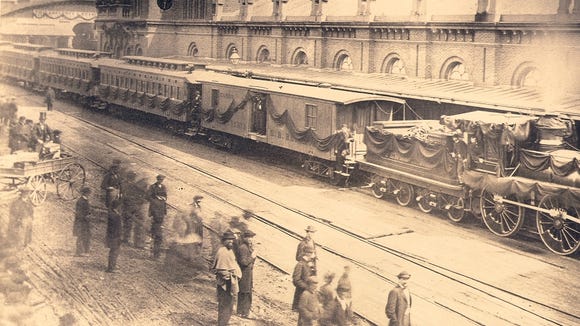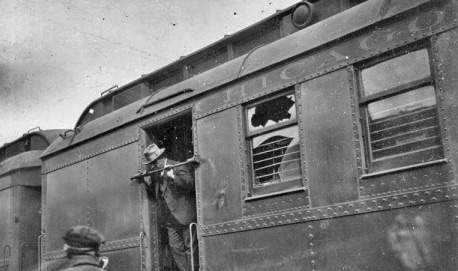I know very little about train travel. I am curious how coffins/caskets were transported in the 1930s to 1940s. Also, would the car they were in have been accessible by passengers? I recently read in a biography that an 8-year-old on a cross country, coast to coast, trip. Would exit the coach car at every stop and enter the car where his mother’s coffin was to check that it was still aboard. As I said I know little about trains, but that seems a little unlikely to me. I would have thought baggage cars with end doors would have been locked. Also, wouldn’t outer doors have been too high for a child that small to access and open? I wouldn’t think baggage cars would have been on the platform when the coach cars were. Just seems like an unlikely scenario.
I do not know if procedures in the thirties were any different from those in the fifties and later, but I never saw that the end door of a baggage car was locked. As to the handling of caskets, they were carried to the baggage cars on the baggage wagons, and loaded just as the checked baggage was loaded.
Some additional considerations: Johnny is right that this likely wasn’t a train with high-level platform access working baggage at every stop, and it’s unlikely that an 8-year-old would be helped up from the ballast at every stop by the baggage man … but I think it’s a safe bet that would happen if a tearful kid wanted to check on his mom at every stop. Same idea for conductors leaving the forward door open or even going with the kid to ‘make sure’.
I thought the doors were locked when there was high value ‘express’ or other such content on the car or when there was no one actually ‘watching’ inside it between stations.
In this modern litigious world can you imagine letting an 8-year-old repeatedly go into a baggage car on a moving train? (Or a typical Antrak car attendant faced with this situation agreeing to accompany him there repeatedly?)
On another forum, someone also said that they seldom saw the end doors locked. They also said passengers were never allowed in the baggage car. He also said cross country trains always had a baggageman working in the baggage car sorting railroad mail, organizing baggage, sorting newspaper bundles and parcels. So, no one could have slipped in under ordinary circumstances. He said, at stops the front of the train was very busy with changing engines, the mail car, and sometimes the baggage car. He said the baggage car would have been being loaded and unloaded and it would have been unlikely anyone entered the car from either the ends or the outside at stops other than employees. Does that seem like a fair assessment?
This is a question I wanted to ask for so long but never actually make a post for it. IIRC, for those secondary trains or overnight named train which didn’t have a dormitory car attached to the consist, the staff or people who were working on the RPO slept or took paid time off inside the baggage car. I guess it was common during World War II when trains were always fully packed with the passenger. Since there were different people kept going in and out of the baggage car, I believe the doors were not locked by the staff for convenience purposes, even though it might be supposed to be locked (especially when there was a coffin or casket inside the baggage car). I heard stories told by the train crew, but haven’t read of stories told by baggageman yet.
I now think of even more questions: was there any special arrangement for the soldier who came home in the coffin during World War II? (no offense!) What was the instruction and procedure for the train crew of different railroads when handling the soldier’s coffins and their family members?


Jeez, this thread’s topic reminds me of this Gilded Age laugh riot…
On a regular passenger train, Railway Post Office cars normally would have been locked and off-limits to passengers and to the railroad train crew. In some cars that were part baggage and part RPO, there was only a small crawlway that could be opened in an emergency so an RPO clerk could go into the baggage section of the car. On a mail train, and RPO sometimes would be open so it could be placed next to a baggage car holding sacks of mail (or between two such cars) so that the clerks could sort the bagged mail while on route.
Baggage cars generally weren’t so strict. I’m sure if a family member riding with a dead person in a coffin wanted to go to the baggage car to check on their loved one, the baggage clerk in the car wouldn’t object.
As far as the actual transport of deceased people in coffins, it would basically be handled like baggage or a large parcel. Railroad workers I’m sure would be as careful as possible when loading the remains into the car, but as far as I know it wouldn’t have been given any special treatment otherwise.
In a military / wartime situation, I don’t know if some branches of the military may have had some rule about having a uniformed escort ride the train with the deceased soldier or sailor. I think, if possible, someone would try to be there to meet the train, like a small color guard (local military members if near a base, or perhaps American Legion / VFW).
I know in the movie “Giant” (1955) there’s a scene set in WW2 where a soldier’s remains are brought home by train to a small town in Texas. Quick search didn’t yield a clip. Since that was filmed so close to WW2 and Korean war, I’d assume the scene would have been at least pretty close to reality in that situation.
Thanks, Wayne. I think you are the best DJ on the Classic Trains forum. [{(-_-)}]
Some background of the song:
http://digitalcollections.uark.edu/cdm/singleitem/collection/OzarkFolkSong/id/654/rec/1
[W]
After posting my earlier post, I found this - seems to have some good info.
Thank you, wjstix. Those are some useful information for my research. By the way, I found the scene in the movie “Giant”:


As I recall, possibly from information found in passenger timetables, the charge for carrying a corpse was a first class fare–perhaps because some people had tried to travel at a lower cost by pretending to be a corpse.
Certainly, respect would be shown for the deceased when a casket was ahndled.
I think the fare was reasonable, it is like an administrative charge nowadays. But for the family who couldn’t afford the fare, assistance from the church might be needed.
Worked the B&O’s depot at Salem, IL in 1966-67. Several times I had to handle caskets of returning Viet Nam war casualties. Handling a casket with 3 people (the baggageman, the funeral home herse driver and myself) was a real chore - made more so be the need to reamain respectful of the deceased.
On RPO’s the mail clerks were all armed and the doors to the RPO would be kept locked. Remember, in the day, it was not uncommon for money and negotiable securities to be sent between parties via US Mail and the mail could be a target for theives.
Thank you for sharing your first-hand experience of working on the baggage car as well as the video, BaltACD. After watching the video, I think I am ready to report for duty. [4:-)]
Thanks for posting that film Balt! It was very interesting to see just what went on in those railcars, especially if you’re like me and have seen them in rail museums but with little interpretation of the mail clerks jobs.
And it was interesting to see they were “packin’ heat” to deter mail robberies.
Did you know Marines were assigned to mailcars once?
Back in 1921 there was a rash of RPO robberies, and some clerks were killed. The Postmaster General asked President Harding what could be done about it, and the President said he’d loan him some Marines. Over 2000 were deployed to RPO cars and mail facilities around the nation. All were armed with .45 automatic pistols and shotguns, two to an RPO car, and ordered to “…shoot to wound or kill…” anyone who attempted to rob the car. Navy Secretary Denby said “I want the mails to get through, or dead Marines in the mailcars!” Denby was a former Marine himself.
Robberies stopped almost overnight. There was a brief resurgence in 1926, Marines were deployed again, and the robberies stopped for good.
Semper Fi!
The robbery of MILW 57 at Rondout in 1924 was an inside job (one of the Postal Inspectors was in on the job) and is known as the last Mail train robbery in the United States.
I believe the fare would be charged to the appropriate branch of the military, not to the family of the deceased. Travel under military orders, including going to basic training, moving between postings, or going home after being discharged was paid by the military IIRC; I doubt they would do that but make gold star families pay to get their son’s remains back home.
My dad’s first job with the post office in 1943 was working as a mail clerk at night out of the main post office in downtown Minneapolis, going to and from the nearby Great Northern and Milwaukee Road stations to pick up and drop off mail. He said the postal clerks normally have very small sidearms; he said he was concerned what would happen if they ever had to shoot them, since from all their years on the trains many clerks had a bad case of ‘the shakes’ and might not be able to aim a gun very accurately.
My dad had to be armed too, but he was usually assigned a large (possibly Spanish-American war) pistol that he described as being more like a small hand-cannon than a pistol. However, the gun was always in perfect condition, as the post office had a full-time gunsmith on duty with his own maintenance and repair shop in the main post office basement.
I did some further checking, and it looks like it was a robbery of a mail truck and killing of the driver that brought Marines back in 1926.
For those interested, here’s the whole story from Marine historic records.
www.angelfire.com/ca/dickg/mailguards.html
I’ve revised my original post on this subject a bit.
Wjstix, I’m surprised those armed mail clerks didn’t have to qualify with those revolvers on a somewhat regular basis, say once a year. I suppose the Post Office assumed the deterrant factor of armed men in the car was good enough.
Interesting, Wayne. I just read about the story of the Rondout train robbery in 1924:
"The thieves then threw bottles of noxious formaldehyde into the windows of the passenger cars, leaving the train’s 17 armed mail clerks gasping for air. When the guards surrendered, the bandits made off with several mail sacks containing a staggering $3 million in cash and bonds. The gang escaped in their cars, but in the confusion of the robbery, an accomplice accidentally shot one of the Newton brothers several times. The thieves were later arrested after they tried to get medical assistance in Chicago.( https://www.history.com/news/6-daring-train-robberies )"
The mail clerks, in this case, needed more than a firearm but an armored RPO to protect themselves… O wait, the whole train should be armored. [:O] [:P]
